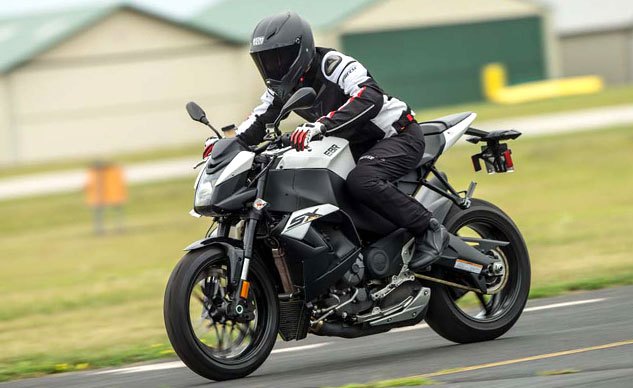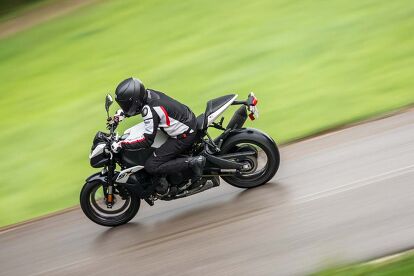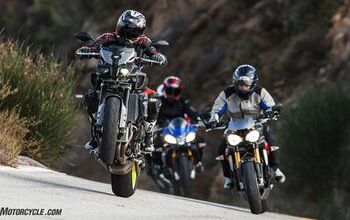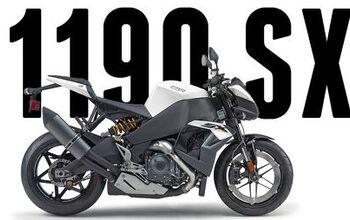2015 EBR 1190SX First Ride Review

Because motorcycles are better when you're naked
The heavyweight Streetfighter category of motorcycles has exploded in popularity lately, with seemingly every manufacturer jumping on the bandwagon for a piece of the pie. Japan’s represented with the Kawasaki Z1000, Honda CB1000R, and even Suzuki is entering the ring in 2015 with the GSX-S1000. Italy’s three representatives include the MV Agusta Brutale 1090RR, Ducati Monster 1200 and Aprilia Tuono V4R. Germany, of course, gives us the BMW S1000R, and we can’t forget BMW’s Austrian neighbors and their contribution to the party: the all-conquering KTM 1290 Super Duke R, Motorcycle.com’s 2014 Motorcycle of the Year.
2015 EBR 1190SX
| Engine | 18.5/20 |
| Suspension/Handling | 14.0/15 |
| Transmission/Clutch | 8.0/10 |
| Brakes | 8.0/10 |
| Instruments/Controls | 3.75/5 |
| Ergonomics/Comfort | 8.5/10 |
| Appearance/Quality | 8.5/10 |
| Desirability | 9.0/10 |
| Value | 7.0/10 |
| Overall Score | 85.25/100 |
With so many players in the game, it’s hard to stand out from the crowd. So what’s a small company like EBR to do? If you’re Erik Buell, you carve a different path, create a new category and become a party of one. Introducing the EBR 1190SX, the all-American Superfighter.
If the SX looks like the 1190RX sans clip-ons and front bodywork, you’re right. During the incredibly short press briefing, the folks in EBR shirts made note to mention the team took a “no compromises” approach to building a superbike for the street. What this means to you and me is EBR simply made the SX a naked version of the RX. Sharing many of the same components as the RX, like the fuel-in-frame chassis, 72-degree, 1190cc, liquid-cooled V-Twin with swirled intake air, and perimeter-style front brake, it’s actually easier to talk about what’s different between the two models: upright handlebars instead of clip-ons, minimal bodywork instead of full fairings, a slightly different underbelly exhaust cover, and a softer shock spring. That’s it. The rest of the SX shares the same part numbers as the RX. Even the EFI tuning is identical to the RX, meaning, unlike other streetfighters, this engine hasn’t been re-tuned or detuned to benefit torque production at the expense of top-end power. Not that the RX’s mill is lacking in this department, anyway.
Superfighter or streetfighter? Tomato or to-mah-toe? Whatever category you want to place the 1190SX in, the EBR matches nicely against three competitors: the Aprilia Tuono V4R, BMW S1000R and KTM 1290 Super Duke R, which just so happened to comprise our 2014 Ultimate Streetfighter Finale. Looking strictly at the numbers in the spec chart below, the EBR appears to be a formidable challenge to its three European competitors. At 1190cc, its engine is significantly larger than both the Aprilia and BMW, while its approximately 160 rear-wheel horsepower and 13.4:1 compression ratio is tops in this field. The KTM’s monstrous 96.5 ft-lbs is still king of the class, 10 up on the EBR, which itself then towers over the Italian and German.
2014 Ultimate Streetfighter Shootout Specs | ||||
|---|---|---|---|---|
| Aprilia Tuono V4R APRC ABS | BMW S1000R | KTM 1290 Super Duke R | EBR 1190SX | |
| MSRP | $14,499 | $14,950 | $16,999 | $16,995 |
| Engine Capacity | 999cc | 999cc | 1301cc | 1190cc |
| Engine Type | 65° V-Four | Inline-Four | 75º V-Twin | 72º V-Twin |
| Bore x Stroke | 78 x 52.3 mm | 80 x 49.7mm | 108 x 71mm | 106 x 67.5mm |
| Compression | 13:1 | 12.0:1 | 13.2:1 | 13.4:1 |
| Horsepower/Torque | 148 hp @ 11,600 rpm / 73.4 ft-lb. @ 9500 rpm | 155.3 hp @ 11,200 rpm / 79.7 ft-lb. @ 9,500 rpm | 156.0 hp @ 9,100 rpm / 96.5 ft-lb. @ 8,200 rpm | 160 hp @ 10,600 rpm / 88 ft-lbs. @ 8200 rpm (approx.) |
| Fuel System | Electronic fuel injection | Electronic fuel injection | Electronic fuel injection | Electronic fuel injection |
| Transmission | Six-Speed | Six-Speed | Six-Speed | Six-Speed |
| Final Drive | Chain | Chain | Chain | Chain |
| Frame | Aluminum dual beam chassis with pressed and cast sheet elements | Aluminum composite bridge frame | Tubular space frame made from chrome molybdenum steel, powder-coated | Aluminum frame with integral fuel reservoir |
| Front Suspension | Sachs 43mm inverted fork with one-by-one separated damping adjustments | Sachs 46mm inverted fork with Dynamic Damping Control semi-active suspension | WP Suspension 48mm inverted fork with adjustable compression and rebound damping | Showa inverted Big Piston Fork |
| Rear Suspension | Sachs piggyback monoshock with adjustable spring preload, compression and rebound damping | Dynamic damping control semi-active suspension | WP Suspension monoshock, fully adjustable | Showa monoshock |
| Front Brakes | Dual 320mm floating discs, Brembo M432 4-piston monoblock radial calipers and ABS | Dual 320mm floating rotors, Brembo fixed radial-mount 4-piston calipers and ABS | Dual 320mm rotors with Brembo M50 4-piston monoblock calipers and ABS | Single 386mm perimeter rotor, 8-piston inside-out caliper |
| Rear Brakes | 220mm disc. Brembo 2-piston floating caliper | Single 220mm rear rotor, single piston floating caliper | Single 240mm rear rotor with two-piston caliper | Single 220mm disc, two-piston Hayes Performance caliper |
| Front Tire | 120/70 ZR17 | 120/70 ZR17 | 120/70 ZR17 | 120/70 ZR17 |
| Rear Tire | 190/55 ZR17 | 190/55 ZR17 | 190/55 ZR17 | 190/55 ZR17 |
| Seat Height | 32.9 in | 32.0 in | 32.9 in | 32.5 in |
| Wheelbase | 56.8 in | 56.7 in | 58.3 in | 55.5 in |
| Rake/Trail | 25.0°/ 4.2 in | 24.6º/3.9 in | 24.9º/4.21 in | 22.4º/3.8 in |
| Curb Weight | 474 lbs | 450 lbs | 469 lbs | 441 lbs. (est.) |
| Fuel Capacity | 4.9 gal | 4.6 gal | 4.7 gal | 4.5 gal |
From there, all four bikes are similarly matched. Seat height is 32.5 inches, directly between the 32.0-inch BMW seat and 32.9 inches for both the Aprilia and KTM. At 55.5 inches, the EBR’s wheelbase is more than an inch shorter than the BMW, the next shortest one of the four at 56.7 inches. The SX also has the most aggressive rake and trail numbers at 22.4 degrees/3.8 inches, respectively. The BMW S1000R, at 24.6 degrees/3.9 inches, almost seems lazy by comparison. Interestingly, EBR lists the 1190SX’s wet weight, minus fuel, at 414 lbs. Factoring in its 4.5-gallon fuel load at 6 lbs per gallon, the SX should come in at approximately 441 lbs. If accurate, then the EBR will come in 9 lbs lighter than the BMW, the lightest bike from our shootout, and a whopping 33 lbs slimmer than the Aprilia!
Numbers Don’t Tell The Whole Story
Being nearly identical to the 1190RX I tested at Indianapolis Motor Speedway only a few weeks prior, what stood out to me about the EBR in a track setting was a seemingly endless amount of torque along with an incredibly agile chassis. Without any street time aboard the RX, however, the SX press ride would provide a glimpse into normal life with both bikes.
Unfortunately, Mother Nature doesn’t seem to cooperate with EBR press launches. First she rained down during the 1190RX launch at the Brickyard, then she did the same on our SX ride day in East Troy, Wisconsin, EBR’s own backyard. The rain was spitting at first, followed by a downpour later in the afternoon.
Nonetheless, a few things stand out about the 1190SX. First, the simple change from clip-ons to handlebars noticeably alters the riding position. It sounds obvious, but the more upright stance is easier on the back and wrists, which is especially appreciated on highway jaunts (either that or I’m just getting old). If it were mine, I’d opt for bars that are slightly higher still, while moving the pegs down to their lowest (of two) positions. This puts the feet about half an inch lower and a quarter-inch forward.
Just as I experienced at Indy, the 1190cc V-Twin is the center of attention. Twisting the throttle is met with an utterly addictive surge of torque that, from the seat-of-the-pants dyno, feels more outrageous to me than even the Super Duke R. And yes, I’m aware how audacious that sounds. No matter the gear and no matter the speed, if the gigantic torque curve the EBR delivers doesn’t put a smile on your face, there’s something wrong with you.
A tall first gear slightly tames that power when leaving a stoplight, but, assuming the traction control isn’t set too high, hoisting a wheelie accidentally will be a fate many experience – not that there’s anything wrong with that. Shifts are done without the help of a quickshifter, though one will be available through EBR parts and accessories in the future and will fit both the SX and RX. Personally, as I was never able to shift cleanly from first to second without using the clutch, opting for the quickshifter option is a no-brainer. That said, shifts through the rest of the gears are smooth. Considering the $16,999 KTM Super Duke R, which is only $4 more than the EBR, is also sans quickshifter (something the $14,950 BMW and $14,499 Aprilia are both equipped with), the lack of one on both the KTM and EBR just doesn’t make sense.
Equally pleasing as the torque are the wonderful sounds the bike makes. It barks loudly at every twist of the wrist, with a mean, two-pronged guttural attack on the senses coming from both the exhaust as well as the huge 61mm throttle bodies as they suck all available air in the vicinity. Although it’s already intoxicating in stock form, an aftermarket pipe will surely make it come alive. As an added bonus, hearing the chain idler whine as it keeps proper tension on decel sounds similar to a supercharger whine, giving the EBRs a distinctive noise unlike anything else out there.
However, good things come at a cost, and once revs exceed the 5000-rpm mark, noticeable vibration is felt through the bars. It’s an annoying buzz that puts hands to sleep quickly if the engine speed is sustained, but fortunately, highway speeds are easily met in higher gears at lower revs. Also, while the radiator fans are placed in a prime location to accept fresh air and expel heat, their positioning blows that hot air directly on your kneecaps.
As you might expect, twisty roads are hard to come by in Wisconsin, and the wet conditions meant exploring the limits on the few corners we did find was out of the question. Nonetheless, the standard Pirelli Diablo Rosso Corsa tires provided impressive grip levels considering the conditions. As with the RX, transitions are made quickly, but the shallow steering sweep makes slow-speed maneuvers, like U-turns for photo passes, a little tricky.
The mixture of rain, street tires and a fat torque curve is a recipe for highsides, but the traction control system employed by EBR, which relies strictly on wheel-speed sensors, provides a safety net for those who get overzealous with the throttle. With 20 different settings (plus off), the lower numbers allow quite a bit of slip before intruding, while the higher numbers virtually eliminate slip entirely. The multi-level settings allow a suitable one for almost any rider.
EBR’s signature 386mm single perimeter brake rotor and 8-piston caliper is fed with a steel-braided line, and though braking performance is strong, I’d stop short of rating it above the Brembo units on all three of the European streetfighters mentioned earlier. With all due respect to Erik Buell’s outside-the-box approach to stopping a motorcycle, the perimeter brake doesn’t quite match up to the M50 calipers on the KTM (and Ducati 1199 Panigale), which provide unmatched levels of power and feel.
EBR On The Move
Considering the infancy of EBR and the limited resources at its disposal, the 1190SX is an impressive machine. With his unique approach to chassis design and braking methods, Erik Buell is setting the 1190SX apart from the rest, which, in the street/superfighter category is an important element for consumers. Then again, so is price. At $16,995, it’s one of the more expensive players in the category and yet it lacks much of the technology of its less expensive rivals, including ride-by-wire throttle actuation, ride modes, cruise control, wheelie control, dynamic suspension, quickshifter and ABS.
However, what the EBR lacks in technology, it makes up for by appealing to the senses – the intangible X-factor. Erik Buell is relying on the torque, agility, sounds, and performance of his bikes to put a smile on your face. A smile big enough to head to one of 82 dealers (and growing) in this country, fork over 17-large and bring one home.
+ Highs
- Torque!
- Good looks in a field of attractive streetfighters
- Relatively comfy ergos for street riding
– Sighs
- Excess heat gets blown to kneecaps
- The cost vs. technology ratio may not add up for some
- Bars are buzzy above 5000 rpm

Troy's been riding motorcycles and writing about them since 2006, getting his start at Rider Magazine. From there, he moved to Sport Rider Magazine before finally landing at Motorcycle.com in 2011. A lifelong gearhead who didn't fully immerse himself in motorcycles until his teenage years, Troy's interests have always been in technology, performance, and going fast. Naturally, racing was the perfect avenue to combine all three. Troy has been racing nearly as long as he's been riding and has competed at the AMA national level. He's also won multiple club races throughout the country, culminating in a Utah Sport Bike Association championship in 2011. He has been invited as a guest instructor for the Yamaha Champions Riding School, and when he's not out riding, he's either wrenching on bikes or watching MotoGP.
More by Troy Siahaan






























































Comments
Join the conversation
Sign me up for a red one
I definitely do love it, but I wish it had the face of the Lightning.